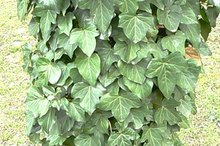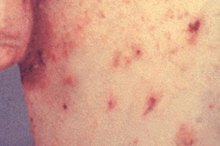What does fact checked mean?
At Healthfully, we strive to deliver objective content that is accurate and up-to-date. Our team periodically reviews articles in order to ensure content quality. The sources cited below consist of evidence from peer-reviewed journals, prominent medical organizations, academic associations, and government data.
The information contained on this site is for informational purposes only, and should not be used as a substitute for the advice of a professional health care provider. Please check with the appropriate physician regarding health questions and concerns. Although we strive to deliver accurate and up-to-date information, no guarantee to that effect is made.
Home Remedies for Poison Sumac
Poison sumac is one of a trio of plants, including poison ivy and poison oak, that cause a rash if a person is allergic to them 1. The plants release urushiol oil, a substance found in the stems, leaves, fruit and leaves, when they are bruised or damaged. Some individuals do not react to urushiol oil, but most of the population is sensitive to it. An intensely itchy rash may appear within 24 to 72 hours. Without treatment, the rash normally will subside within several weeks. See your doctor if the rash spreads to your eyes, mouth or genitals -- further treatment may be required.
Washing
Washing the entire body with soap and water within 10 to 15 minutes of contact with poison sumac may prevent a rash by removing the urushiol oil from the body, which adds that commercial products such as Goop or Tecnu may be even more effective. Shoes, clothing, tools and anything else that came into contact with the plant should be cleaned with alcohol and water to prevent repeat contact with the skin. If left on objects, urushiol oil can cause an allergic reaction years later.
Soothing
Consequences of a Prolonged Poison Ivy Rash
Learn More
If a rash and blisters develops, the patient should avoid scratching the skin because organisms can enter the broken areas and cause an infection. To soothe the itching and reduce swelling, the individual can apply cool compresses to the skin or soak in a cool bath several times a day. Oatmeal or baking soda added to the bath water may be helpful. Burows solution, also called aluminum acetate solution, may be applied to the blistered areas two or three times a day for 20 minutes. To prepare the treatment, one or two over-the-counter Dome-Boro tablets should be mixed in 1 pt. of water, then compresses soaked in the solution should be applied to the affected skin.
- If a rash and blisters develops, the patient should avoid scratching the skin because organisms can enter the broken areas and cause an infection.
- To soothe the itching and reduce swelling, the individual can apply cool compresses to the skin or soak in a cool bath several times a day.
Medications
Over-the-counter medications can help to reduce swelling and itching. Calamine lotion or corticosteroid creams may be applied to the skin. Diphenhydramine, an antihistamine, can be given by mouth to relieve itching and help the people to sleep. Zinc oxide can help to protect the skin and dry the blisters. Prescription medications, including antibiotics for an infection and corticosteroids for widespread rashes, may be needed if home remedies are not effective.
- Over-the-counter medications can help to reduce swelling and itching.
- Zinc oxide can help to protect the skin and dry the blisters.
Related Articles
References
- U.S. Food and Drug Administration: Outsmarting Poison Ivy and Other Poisonous Plants
- Boston Children's Hospital. Poison Ivy, Poison Oak and Poison Sumac.
- American Academy of Dermatology. Poison Ivy, Oak, and Sumac: Who gets a rash and is it contagious?
- Prok L, McGovern T. Patient education: Poison ivy (Beyond the Basics). UpToDate. Updated March 25, 2019.
- U.S. Food and Drug Administration. Outsmarting Poison Ivy and Other Poisonous Plants. Updated August 6, 2016.
- Porter R. Poison Ivy, Poison Oak and Poison Sumac. National Capital Poison Center.
- Usatine RP, Riojas M. Diagnosis and management of contact dermatitis. Am Fam Physician. 2010;82(3):249-55.
- MedlinePlus. Bentoquatam Topical. Updated February 15, 2018.
- American Academy of Dermatology. (2018). Poison ivy, oak, and sumac. https://www.aad.org/public/diseases/itchy-skin/poison-ivy-oak-and-sumac
- Curtis G, Lewis AC. Treatment of severe poison ivy: a randomized, controlled trial of long versus short course oral prednisone. J Clin Med Res. 2014 Dec;6(6):429-34. doi: 10.14740/jocmr1855w.
- Habif TP. Clinical Dermatology: A Color Guide to Diagnosis and Therapy. Elsevier; 2016.
- U.S. Food and Drug Administration. (2016). Outsmarting Poison Ivy and Its Cousins. https://www.fda.gov/ForConsumers/ConsumerUpdates/ucm049342.htm
Writer Bio
Marcy Brinkley has been writing professionally since 2007. Her work has appeared in "Chicken Soup for the Soul," "Texas Health Law Reporter" and the "State Bar of Texas Health Law Section Report." Her degrees include a Bachelor of Science in Nursing; a Master of Business Administration; and a Doctor of Jurisprudence.








